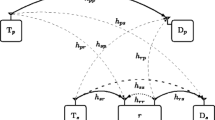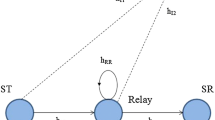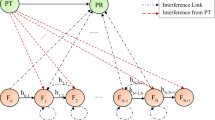Abstract
This paper investigates the outage probability performance of the secondary user (SU) in an underlay dual-hop, decode and forward (DF), full duplex cognitive relay network (FDCRN). First, we develop analytical closed form expression for outage probability and throughput for a dual-hop DF FDCRN by making use of the direct link signal as a useful signal to improve the signal-to-noise ratio at the secondary destination. Next, we compare the outage and throughput performance of various FDCRN and half duplex cognitive relay network (HDCRN) protocols, namely, (1) dual-hop DF FDCRN with direct link treated as interference, (2) dual-hop DF FDCRN with direct link signal cancelled by employing recursive backward interference cancellation technique, and (3) dual-hop DF HDCRN that employs maximal ratio combining at SD. Closed form expressions for the outage probabilities experienced in the secondary network are derived by taking into account the residual self-interference at the full duplex relay node, in independent non-identical Rayleigh fading channels. The analysis considers the maximum transmit power constraint of the individual secondary nodes and the tolerable interference threshold power constraint of the primary destination as well. The results demonstrate that the outage performance of the SU gets improved significantly when the direct link is exploited at the secondary destination. Further, we evaluate the impact of relay location and the power allocation ratio among secondary source and relay on the outage probability. The analytical results are validated by extensive Monte-Carlo simulations.












Similar content being viewed by others
References
Mitola, J., & Maguire, G. Q. (1999). Cognitive radio: Making software radios more personal. IEEE Personal Communications, 13(18), 4–6.
Goldsmith, A., Jafar, S. A., Maric, I., & Srinivasa, S. (2009). Breaking spectrum gridlock with cognitive radios: An information theoretic perspective. Proceedings of the IEEE, 97(5), 894–914.
Simon, H. (2005). Cognitive radio: Brain-empowered wireless communications. IEEE Journal on Selected Areas in Communications., 23(2), 201–220.
Wang, B., & Liu, K. J. R. (2011). Advances in cognitive radio networks: A survey. IEEE Journal of Selected Topics in Signal Processing, 5(1), 5–23.
Andrew, S., Elza, E., & Behnaam, A. (2003). User cooperation diversity. Part I. System description. IEEE Transactions on Communications., 51(11), 1927–1938.
Laneman, J. N., Tse, D. N. C., & Wornell, G. W. (2004). Cooperativediversity in wireless networks: Efficient protocols and outagebehavior. IEEE Transactions on Information theory, 50(12), 3062–3080.
Letaief, K. B., & Zhang, W. (2009). Cooperative communications for cognitive radio networks. Proceedings of the IEEE, 97(5), 878–893.
Sabharwal, A., Schniter, P., Guo, D., Bliss, D. W., Rangarajan, S., & Wichman, R. (2014). In-band full-duplex wireless: Challenges and opportunities. IEEE Journal on Selected areas in Communications, 32(9), 1367–1652.
Melissa, D., Chris, D., & Ashutosh, S. (2012). Experiment-driven characterization of full-duplex wireless systems. IEEE Transactions on Wireless Communications., 11(12), 4296–4307.
Zhang, Z., Xiaomeng, C., Keping, L., Vasilakos, A. V., & Hanzo, L. (2015). Full duplex techniques for 5G networks: Self-interference cancellation, protocol design, and relay selection. IEEE Communications Magazine, 53(5), 128–137.
Evan, Everett, Debashis, Dash, Chris, Dick, & Ashutosh, Sabharwal. (2011). Self-interference cancellation in multi-hop full-duplex networks via structured signaling. In 49th Annual Allerton conference on communication, control, and computing (Allerton) (pp. 1619–1626). IEEE
Björn, D., Dirk-Jan, B., Cristina, L., et al. (2014). Analog/RF solutions enabling compact full-duplex radios. IEEE Journal on Selected Areas in Communications, 32(9), 1662–1673.
Taneli, R., Stefan, W., & Risto, W. (2011). Mitigation of loopback self-interference in full-duplex MIMO relays. IEEE Transactions on Signal Processing, 59(12), 5983–5993.
Taehoon, K., Sungmook, L., Sooyong, C., & Daesik, H. (2010). Optimal duplex mode for DF relay in terms of the outage probability. IEEE Transactions on Vehicular Technology, 59(7), 3628–3634.
Liu, G., Yu, F. R., Hong, J., Leung, V. C. M., & Li, X. (2015). In-band full-duplex relaying: A survey, research issues and challenges. IEEE Communications Surveys and Tutorials, 17(2), 500–524.
Yun, L., Lingyang, S., Zhu, H., & Yonghui, L. (2015). Full duplex cognitive radio: A new design paradigm for enhancing spectrum usage. IEEE Communications Magazine, 53(5), 138–145.
Lin, W., Wang, Y., & Li, F. Y. (2015). A multi-phase decode-and-forward transmission protocol in cognitive relay networks: Outage analysis and relay power allocation. In 81st Vehicular technology conference (VTC Spring) (pp. 1–5). IEEE.
Zhu, J., Huang, J. & Zhang, W. (2010). Optimal one-dimensional relay placement in cognitive radio networks. In International conference on wireless communications and signal processing (WCSP) (pp. 1–6). IEEE
Tran, T.-T., Bao, V. N. Q., Thanh, V. D., & Duong, T. Q. (2013). Performance analysis and optimal relay position of cognitive spectrum-sharing dual-hop decode-and-forward networks. In 2013 International conference on computing, management and telecommunications (ComManTel) (pp. 269–273). IEEE.
Shu, Z., & Chen, W. (2010). Optimal power allocation in cognitive relay networks under different power constraints. In IEEE International conference on wireless communications, networking and information security (WCNIS) (pp. 647–652). IEEE.
Mafra, S. B., Alves, H., Costa, D. B., Souza, R. D., Fernandez, E. M. G., & Latva-aho, M. (2015). On the performance of cognitive full-duplex relaying under spectrum sharing constraints. EURASIP Journal on Wireless Communications and Networking, 2015(1), 169.
Li, N., Li, Y., Wang, T., Peng, M., & Wang, W. (2015). Full-duplex based spectrum sharing in cognitive two-way relay networks. In 2015 IEEE 26th annual international symposium on personal, indoor, and mobile radio communications (PIMRC) (pp. 997–1001). IEEE.
Hongbin, C., Songgao, T., & Feng, Z. (2015). Outage performance of relay-assisted transmissions in cognitive full-duplex relay networks. EURASIP Journal on Wireless Communications and Networking, 2015(1), 1–11.
Doan, X.-T., Nguyen, N.-P., Yin, C., Da Costa, D. B., & Duong, T. Q. (2017). Cognitive full-duplex relay networks under the peakinterference power constraint of multiple primary users. EURASIP Journal on Wireless Communications and Networking, 2017, 1–10.
Tan, L. T., Ying, L., & Bliss, D. W. (2017). Power control and relay selection in full-duplex cognitive relay networks: Coherent versus non-coherent scenarios. In 2017 51st Annual conference on information sciences and systems (CISS) (pp. 1–6). IEEE.
Hyungjong, K., Sungmook, L., Hano, W., & Daesik, H. (2012). Optimal power allocation and outage analysis for cognitive full duplex relay systems. IEEE Transactions on Wireless Communications, 11(10), 3754–3765.
Yin, C., Doan, T. X., Nguyen, N.-P., Mai, T., & Nguyen, L. D. (2017). Outage probability of full-duplex cognitive relay networks with partial relay selection. In International conference on recent advances in signal processing, telecommunications & computing (SigTelCom) (pp. 115–118). IEEE.
Rajkumar, S., & Jayaraman S, T. (2016). Outage analysis of OFDM based cognitive radio network with full duplex relay selection. IET Signal Processing, 10(8), 865–872.
Olivo, E. E. B., Osorio, D. P. M., Alves, H., Santos, F. J. C. S., & Latva-aho, M. (2016). An adaptive transmission scheme for cognitive decode-and-forward relaying networks: Half duplex, full duplex, or no cooperation. IEEE Transactions on Wireless Communications, 15(8), 5586–5602.
Chu, T. M. C., & Zepernick, H.-J. (2017). On capacity of full-duplex cognitive cooperative radio networks with optimal power allocation. In 2017 IEEE wireless communications and networking conference (WCNC) (pp. 1–6). IEEE.
Alves, H., Costa, D. B., Souza, R. D., & Latva-aho, M. (2013). Performance of block-Markov full duplex relaying with self interference in Nakagami-m fading. IEEE Wireless Communications Letters, 2(3), 311–314.
Osorio, D. P. M., Olivo, E. E. B., Alves, H., Santos, F. J. C. S., & Latva-aho, M. (2015). Exploiting the direct link in full-duplex amplify-and-forward relaying networks. IEEE Signal Processing Letters, 22(10), 1766–1770.
Mohammad, K., Amr, I., Mohamed-Slim, A., & Sonia, A. (2013). On the outage performance of full-duplex selective decode-and-forward relaying. IEEE Communications Letters, 17(6), 1180–1183.
Alves, H., Fraidenraich, G., Souza, R. D., Bennis, M., & Latva-aho, M. (2012). Performance analysis of full duplex and selective and incremental half duplex relaying schemes. IEEE Wireless Communications and Networking Conference (WCNC), 1, 771–775.
Khafagy, M. G., Ismail, A., Alouini, M.-S., & Aïssa, S. (2015). Efficient cooperative protocols for full-duplex relaying over Nakagami-\(m\) fading channels. IEEE Transactions on Wireless Communications, 14(6), 3456–3470.
Chen, Z., & Quek, T. Q. S. (2016). Coherent signaling for full-duplex relay channel with self-interference. IEEE Communications Letters, 20(9), 1792–1795.
Chen, Z., Quek, T. Q. S., & Liang, Y.-C. (2017). Spectral efficiency and relay energy efficiency of full-duplex relay channel. IEEE Transactions on Wireless Communications, 16(5), 3162–3175.
Sikora, M., Laneman, J. N., Haenggi, M., Costello, D. J., & Fuja, T. E. (2006). Bandwidth and power-efficient routing in linear wireless networks. IEEE Transactions on Information Theory, 52(6), 2624–2633.
Boyer, J., Falconer, D. D., & Yanikomeroglu, H. (2004). Multihop diversity in wireless relaying channels. IEEE Transactions on Communications, 52(10), 1820–1830.
Alan, Jeffrey, & Daniel, Zwillinger. (2007). Table of integrals, series, and products. Cambridge: Academic Press.
Author information
Authors and Affiliations
Corresponding author
Ethics declarations
Conflict of interest
The authors declare that they have no conflict of interest.
Additional information
Publisher's Note
Springer Nature remains neutral with regard to jurisdictional claims in published maps and institutional affiliations.
Appendices
Appendix
A Derivation of (10) and (11):
Let the random variables P and Q be defined as follows:
\(P=min \left( P_{S,max},\frac{\zeta I_{th}}{ \vert h_{SP} \vert ^2} \right) \vert h_{SR} \vert ^2\)
\(Q=min \left( P_{R,max},\frac{(1-\zeta ) I_{th}}{ \vert h_{RP} \vert ^2} \right) \vert h_{RR} \vert ^2\).
First let us determine the CDF and PDF of P, which is useful for our derivation.
Similarly, the PDF of Q, \(f_Q(q)\) can be obtained from (35), by replacing the corresponding distributions as,
Now, using the SINRs defined in (6) and (7), the CDF \(F_{\varGamma _{R,1}}(\varGamma _{FD,1})\) is derived as follows:
Making use of the distributions defined earlier in (35) and (37), and [ [40], eqns. (3.352.4) and (3.353.3) ], the integral expression in (38) can be simplified to obtain a closed form expression as shown in (10).
Similarly, let T and U be denoted respectively as,
\(T=min \left( P_{R,max},\frac{(1-\zeta ) I_{th}}{\vert h_{RP} \vert ^2} \right) \vert h_{RD} \vert ^2\) and \(U=min \left( P_{S,max},\frac{\zeta I _{th}}{ \vert h_{SP} \vert ^2} \right) \vert h_{SD} \vert ^2\).
Now, the CDF \(F_{\varGamma _{D,1}}(\varGamma _{FD,1})\) can be evaluated as:
The CDF \(F_U(u)\) and the PDF \(f_T(t)\) in 39 can be determined from (35), and (36) respectively, by substituting the corresponding distributions, as follows:
Simplifying the integral in (39) using (40), (41) and [40], eqns. (3.352.1) and (3.353.1) ], the closed form solution can be obtained as in (11).
B Derivation of (17) and (18):
The closed form expansion for \(F_{\varGamma _{R,2}}(\varGamma _{FD,2})\) is same as that of \(F_{\varGamma _{R,1}}(\varGamma _{FD,1})\), which is already proved in “Appendix A”.
The CDF \(F_{\varGamma _{D,2}}(\varGamma _{FD,2})\) is defined as :
Notice that the integral in (42) is identical to that of (38). Therefore, the closed form expression for \(F_{\varGamma _{D,2}}(\varGamma _{FD,2})\) given by (18), can be determined from (10) by exchanging \(P_{S,max}\) and \(P_{R,max}\), and by replacing the mean channel gains of \(h_{SR}\), \(h_{SP}\), \(h_{RP}\) and \(h_{RR}\) by that of \(h_{RD}\), \(h_{RP}\), \(h_{SP}\) and \(h_{SD}\) respectively.
C Derivation of (23) and (24):
The CDF \(F_{\varGamma _{R,3}}(\varGamma _{FD,3})\), given is same as that of \(F_{\varGamma _{R,1}}(\varGamma _{FD,1})\). The detailed proof is available in “Appendix A”.
The CDF \(F_{\varGamma _{D,3}}(\varGamma _{FD,3})\) is determined as follows:
where T is given by, \(T=\frac{P_R }{N_0}\vert h_{RD} \vert ^2\). The derivation for the CDF of T, \(F_T(\varGamma _{FD,3})\) is similar to that of \(F_P(p)\) derived in (35). Thus, the closed form expression for \(F_T(\varGamma _{FD,3})\), can be easily obtained from (35), by substituting \(p=\varGamma _{FD,3}\), \(P_{S,max}=P_{R,max}\), \(\lambda _{SR}=\lambda _{RD}\) and \(\lambda _{SP}=\lambda _{RP}\).
D Derivation of (33)
The outage probability of the cognitive HDCRN-MRC scheme is given by,
where \(V=min(P,T)\); \(P=min \big (P_{S,max},\frac{I_{th}}{ \vert h_{SP} \vert ^2} \big ) \vert h_{SR} \vert ^2\); \(T=min \big (P_{R,max},\frac{I_{th}}{\vert h_{RP} \vert ^2} \big ) \vert h_{RD} \vert ^2\). To evaluate the integral in (44), we need to determine the PDF of U and the CDF of V. The PDF \(f_U(u)\) is given by,
which is obtained from (36), by replacing \(\lambda _{SR}\) by \(\lambda _{SD}\) and \(\zeta =1\).
The CDF \(F_V(v)\) is determined as follows:
The integral expression for \(K_1(v)\) is solved using (35), (36), (36), (41) and [[40] eqns. (3.352.4), (3.353.1) and (3.353.3)] to get,
where \(\hat{a_0}=P_{S,max}\lambda _{SR}\), \(\hat{a_1}=e^{-\frac{I_{th}}{P_{S,max}\lambda _{SP}}}\), \(\hat{a_2}=\frac{I_{th}\lambda _{SR}}{\lambda _{SP}}\), \(\hat{b_0}=P_{R,max}\lambda _{RD}\)\(\hat{b_1}=e^{-\frac{I_{th}}{P_{R,max}\lambda _{RP}}}\), \(\hat{b_2}=\frac{I_{th}\lambda _{RD}}{\lambda _{RP}}\), \({\hat{\mu }}=\frac{1}{P_{R,max}\lambda _{RD}}+\frac{1}{P_{S,max}\lambda _{SR}}\), \(\delta _0=\hat{a_1}\hat{a_2}\big [1-\frac{\hat{b_1}\hat{a_2}}{\hat{a_2}-\hat{b_2}}-\frac{\hat{a_0}\hat{b_1}\hat{b_2}}{(\hat{a_2}-\hat{b_2})^2}\big ]\), \(\delta _1=\hat{b_1}\hat{b_2}\big [1+ \frac{\hat{a_1}\hat{b_2}}{(\hat{a_2}-\hat{b_2})} +\frac{\hat{a_0}\hat{a_1}\hat{a_2}}{(\hat{a_2}-\hat{b_2})^2}\big ]\) and \(\delta _2=\hat{a_0}\hat{a_1}\hat{a_2}(1-\frac{\hat{b_1}\hat{a_2}}{(\hat{a_2}-\hat{b_2})})\). \(K_2(v)\) is obtained from \(K_1(v)\) by interchanging \(\hat{a_i} , i=\{0,1,2\}\) and \(\hat{b_i} , i=\{0,1,2\}\) as follows:
where \(\delta _3=\hat{b_0}\hat{b_1}\hat{b_2}(1-\frac{\hat{a_1}\hat{b_2}}{(\hat{a_2}-\hat{b_2})})\). The final expression for \(P_{out,HD}^{MRC}\) can be evaluated from (44–47) to get (33). The closed form solution is not obtained, but the integral in (33) can be easily evaluated using numerical integration in Matlab.
Rights and permissions
About this article
Cite this article
Poornima, S., Babu, A.V. Outage Performance Comparison of Dual-Hop Full Duplex Underlay Cognitive Relay Networks. Wireless Pers Commun 106, 1135–1160 (2019). https://doi.org/10.1007/s11277-019-06207-2
Published:
Issue Date:
DOI: https://doi.org/10.1007/s11277-019-06207-2




